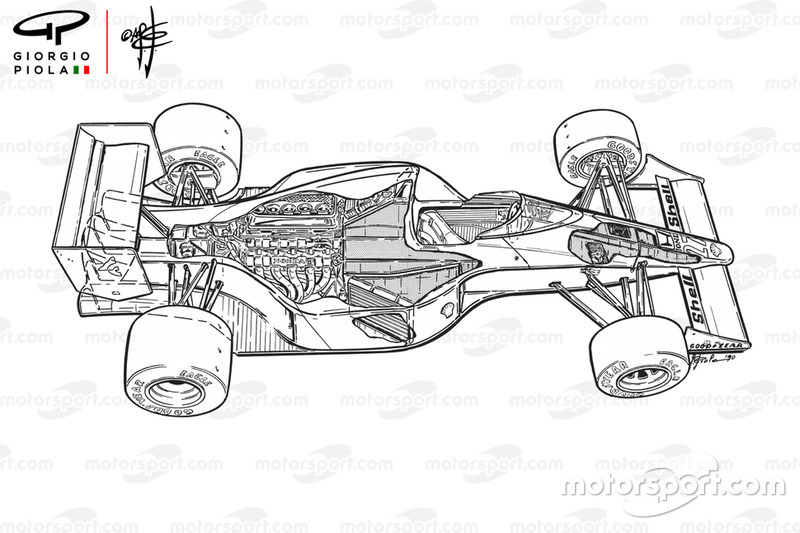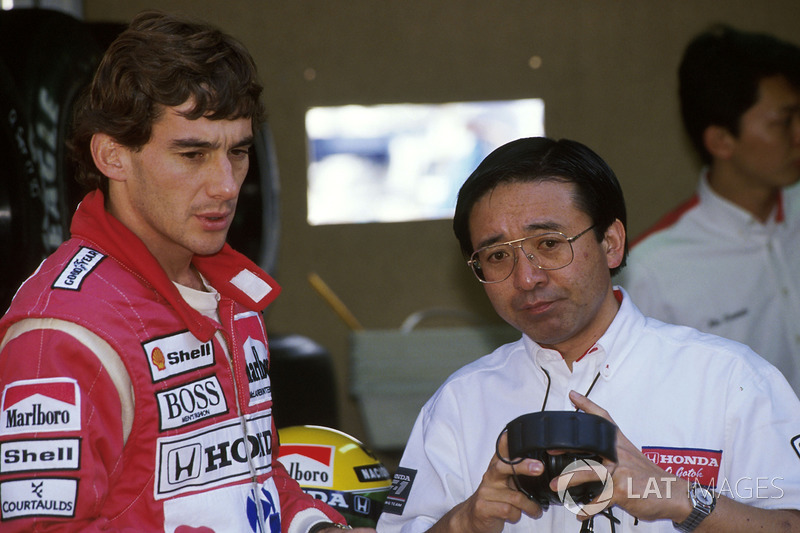The new collection – available by clicking here – will breathe new life into these already highly-detailed illustrations, marrying his illustrative work of the past with the modern techniques he employs today.
The Piola story
Speaking freely about his craft, Piola characterizes his time in the paddock as having three distinct chapters – the first of which comprises a time when he would sit at his drawing board for up to 40 days, creating some extremely large and exquisitely detailed cutaway drawings, laying bare the technical detail of the machine he was focused on.
These are pieces of art in their right and feature techniques that make each aspect of the car jump off the page and tell their own story – such as this fantastic Lotus 72D below...

Lotus 72D 1972 detailed overview
Photo by: Giorgio Piola
Carving out a career that had previously not existed in Formula 1 led to Piola’s stock rising considerably, and he soon found that demand for his illustrative work had accelerated around the world. To meet these demands he reacted much like the sport he captures, innovating, adapting and thinking laterally to meet the needs of this new challenge.
During this chapter in his career, the fax machine had become how his work would be distributed and meant they could be published before he’d even arrived back from a Grand Prix weekend. This required a cleaner, more simplistic technique, the drawings becoming more like sketches when compared with those that had come before them…

Toleman TG184 1984 rear wings detail
Photo by: Giorgio Piola
The third chapter of his illustrious career began in the mid-’90s when Piola began to develop the computer-aided techniques he’s continued to develop over the last few decades. This method has allowed him to amalgamate his previous techniques – high detail, highlighting for conveying areas of change or critical focus and a new high level of aesthetic appeal from the rich colorization of the subject matter – such as this amazing Ferrari 2003-GA below.

Ferrari F2003-GA exploded view
Photo by: Giorgio Piola
-
This image is also available in print format and forms part of Piola’s personally-curated collection
The Legacy Collection
The four cars that have been painstakingly remastered for this new legacy collection are the Toleman TG184, Lotus 99T, McLaren MP4/4, and McLaren MP4/5. Click on the arrows below to see how Giorgio has colorized the McLaren...
Giorgio Piola's original black and white illustration of the McLaren MP4/4

Giorgio Piola's colorized illustration of the McLaren MP4/4

The final product, which uses Piola’s modern colorization techniques and took approximately 6-8 hours per car to complete.
How Piola revisited them
The original images, all of which were created in the second chapter of Piola’s career, we're a little tired and had to be digitally cleaned once scanned. The images still carry their original thicker line DNA too, which adds character to the colorized conversion that might have otherwise been lost had the illustrations been done from scratch. Here are the originals, and the story behind each car...

Toleman TG184 1984 detailed overview
Photo by: Giorgio Piola
The Toleman TG184 was a unique design from Rory Byrne, featuring a tandem rear wing setup that proved to be extremely effective at a rain-soaked Monaco GP. Senna had started down in 13th and produced a wet-weather masterclass, scything his way through the field until he eventually took the lead.
The result was later overturned due to the timing of the red flag that ended the race, but it was a defining moment in the Brazilian’s career and gave the F1 world its first glimpse of rare talent.

Lotus 99T 1987 detailed side view
Photo by: Giorgio Piola
Senna went on to enjoy success with Lotus and Renault, but it was in '87 – the first year of the Lotus-Honda partnership – that the Senna-Lotus partnership delivered its best results, the Camel-liveried, active suspension-equipped 99T helping Senna to two victories and eight podiums.

McLaren MP4-4 1988 overall view
Photo by: Giorgio Piola
The McLaren MP4/4 was a formidable machine and one that was victorious at every race in 1988, except one. Senna recorded eight victories that season and stood on the podium a further three times, allowing him to collect the most coveted prize in the sport – his first drivers' world championship.
The Steve Nichols-designed MP4/4 carried forth the technology of its forebears, but the influence of Gordon Murray’s low line design philosophy, first seen at Brabham, was also present. Like the BT55 the drivers were reclined much further in the cockpit than had previously been considered conventional, whilst the V6 turbocharged Honda engine and gearbox also sat as low as possible so that the team could get the maximum from their aerodynamic package.

McLaren MP4-5B 1990
Photo by: Giorgio Piola
The MP4/5B helped deliver Senna’s second drivers championship and featured a reworked Honda V10 engine. It was an anecdote regarding Honda’s 10-cylinder engine that Piola recalled when discussing this car, as he had a good relationship with Osamu Goto, Honda’s chief designer (below).

Ayrton Senna, McLaren Honda MP4/5B with Honda engine guru Osamu Goto
Photo by: Sutton Images
He talked about how rumors had been circulating about their V10 engine before the V6 turbocharged engines were banned for 1989. Piola, having bumped into Honda’s Osamu Goto in the morning at the German GP, asked: “How many engines do you have in the test bank, so that you will be reliable?” Goto looked at Piola, smiled and said: “Possible 4 o’clock” and promptly left.
A bewildered Piola, unable to fathom his response went about his day, until at a certain moment, strolling through the F1 Paddock, Goto appeared again, stopped Piola in his tracks and said: “10, 10 in the test bank” – then disappeared once again!
Looking at his watch, Piola realized what had happened. It was 4 pm and while Osamu Goto was the one responsible for the Honda program in Formula 1, he had waited for permission from Honda in Japan before he could reveal this detail to Piola.
The Legacy collection of fine art prints and posters can be found by clicking here – where you’ll be able to take advantage of a special introductory offer that includes a four-poster set when you buy any of the five fine art prints.
 FREE SHIPPING ON US ORDERS · 90 DAY RETURNS
FREE SHIPPING ON US ORDERS · 90 DAY RETURNS 
Leave a comment